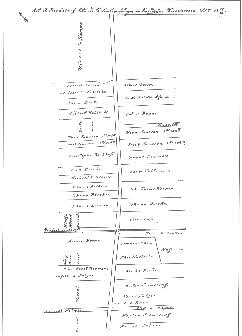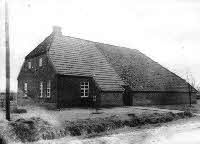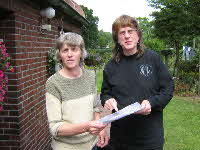|
Wiesede as a place is mentioned already in the 14th century; Wiesedermeer was settled after 1735. No serious attempts were made to settle the Wiesmoor from the east. Three men from Stikelkamperfehn presented a petition to be allowed to settle the Wiesmoor. Reservations expressed by neighboring communities, who feared a further burden on their welfare treasury, were not acknowledged by the Prussian king.
Thus, the first settlers came in 1796 and thus the founding of Wiesederfehn.
 Wiesederfehn grew quickly. There were 111 residents in 1820 with 24 houses; in 1871 there were 410 with 71 homes. Half of all the settlement areas had new occupants after 1797. Rye, oats, and buckwheat crops were the basic resources for living and income. In contrast to the settlers at Vossbarg, the Wiesederfehn occupants were able to sell their peat in the Wittmund area. The production of honey was particularly lucrative and the yearly honey market held at Hopels in the fall became widely famous. Sheep raising was an additional important branch of business, along with the raising of beef, cows, horses, pigs, and chickens. For all that, the colonists or settlers, who had started a new without anything, and in spite of their hard work, did not prosper; only bare necessities were wrung from the hard labor. The census of the area rose steadily until the middle of the 19th century. However, the business and political situation of the times convinced many residents from Wiesederfehn to emigrate and to try their luck in far off America. Wiesederfehn grew quickly. There were 111 residents in 1820 with 24 houses; in 1871 there were 410 with 71 homes. Half of all the settlement areas had new occupants after 1797. Rye, oats, and buckwheat crops were the basic resources for living and income. In contrast to the settlers at Vossbarg, the Wiesederfehn occupants were able to sell their peat in the Wittmund area. The production of honey was particularly lucrative and the yearly honey market held at Hopels in the fall became widely famous. Sheep raising was an additional important branch of business, along with the raising of beef, cows, horses, pigs, and chickens. For all that, the colonists or settlers, who had started a new without anything, and in spite of their hard work, did not prosper; only bare necessities were wrung from the hard labor. The census of the area rose steadily until the middle of the 19th century. However, the business and political situation of the times convinced many residents from Wiesederfehn to emigrate and to try their luck in far off America.
Though it had belonged to the county of Wittmund for ages, Wiesederfehn was assigned to be a part of the county of Aurich as a result of the Gebietsreform of 1972 (district and regional realignments of 1972).
Wiesederfehn, June, 2008
Like so many descendants of East Frisian emigrants, Gloria Rohlfs from Philadelphia, PA, USA, was seeking her roots. Her great-great-grandfather, Meine Janssen Rohlfs, supposedly was born in Marx, married Hilke Catharina Hespen in Reepsholt and lived in a house at Nr. 20 in Wiesederfehn.
In her search for more information in Germany, Gloria sought help from the on-line forum for those named “Rohlfs” see www.bernd-rohlfs.de/forum/index.html.
Bernd Rohlfs was aware of the informational website about Wiesmoor and directed her inquiry to me. In Strackholt’s local genealogical reference book, I discovered additional particulars about M.J. Rohlfs and his family because he’d been a colonist in Voßbarg, where his son Johann Harms Rohlfs, Gloria’s great-grandfather was born. However, the last child was born in Wiesederfehn, so one must assume that the family later lived there. Johann emigrated to Iowa, USA, in 1876. The rest of the children also emigrated, and M.J. Rohlfs later followed them after his wife’s death in 1880.
Prior to Gloria’s trip to Ostfriesland in June, 2008, I’d been able to determine which plot of land M.J. Rohlfs had lived on in Wiesederfehn, based upon the old address information.
 In response to our request for help, Stephan Gerdes from Wiesederfehn attempted to locate the residence and actually achieved success with the Harms family! The house of Meine Janssen and Hilke Catharine (nee Hespen) Rohlfs stood on the property where the Harms family’s farmhouse now stands, Hauptstraße 61. Annagrete Harms’ mother-in-law recalled that she and her husband had demolished the old house and used some of its stones to build their new home. There had been a crossbeam over the entryway, in which the initials “M.J.R.“ were engraved. In response to our request for help, Stephan Gerdes from Wiesederfehn attempted to locate the residence and actually achieved success with the Harms family! The house of Meine Janssen and Hilke Catharine (nee Hespen) Rohlfs stood on the property where the Harms family’s farmhouse now stands, Hauptstraße 61. Annagrete Harms’ mother-in-law recalled that she and her husband had demolished the old house and used some of its stones to build their new home. There had been a crossbeam over the entryway, in which the initials “M.J.R.“ were engraved.
 On Monday the 23rd. Gloria Rohlfs, accompanied by H.-Jürgen Adams, was a guest of the Harms family in Wiesederfehn, at which time Annagrete Harms presented to her the above photograph of M.J. Rohlfs’ house. On Monday the 23rd. Gloria Rohlfs, accompanied by H.-Jürgen Adams, was a guest of the Harms family in Wiesederfehn, at which time Annagrete Harms presented to her the above photograph of M.J. Rohlfs’ house.
In an additional adventure, on Thursday the 26th. Gloria Rohlfs was graciously received at Hauptstr. 91 by Mrs. Hespen, a member of her great-great-grandmother’s family.
Thanks and congratulations to all who participated in this successful fulfillment of a significant personal moment in history!
By the way, Hilke Catharina Hespen was the daughter of Johann Harms Hespen, whose farm can be found on the map above.
|